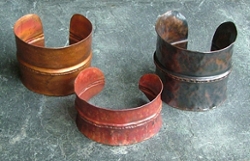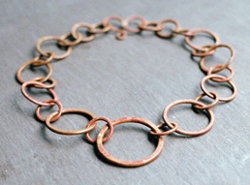Teaching the Touch of Copper and Brass
 Ellen Ball Studio Cold Formed Bracelets
Ellen Ball Studio Cold Formed BraceletsEllen Ball had a long but worthwhile road to finding her love of creating copper jewelry.
“I never went anywhere without a sketchbook, and I grew up in a house full of tools,” Ball says about her early childhood days. Her father worked as an engineer, painter and cook. Her mother practiced interior design as a career.
In the early 2000s, Ball found herself writing poetry and learning to weld. She originally worked with copper wire and sheeting through cold forging. After several decades immersing herself in crafting note cards, invitations, small paintings, collages, pottery and installation art, she opened Ellen Ball Studios in 2008.
“In 2009 while searching copper jewelry images, I discovered foldforming and flipped out,” she says of her excitement in finding a new approach to working with copper. “It really did remind me of how armor is made, so I bought the book Foldforming by Charles Lewton-Brain.
“Talk about flipping a switch,” she says. “I’ve been foldforming copper ever since and even demonstrated it at the North Carolina Artist Blacksmith’s Association of North America quarterly meeting in March 2012.”
Ball has taken numerous metalsmithing courses in recent years and is now teaching, too, largely for arts councils and galleries within an hour of her hometown.
Two classes in enameling at the John C. Campbell Folk School in Brasstown, North Carolina piqued Ball’s zeal even more.
Today, Ball still has a cold forged copper birdbath she made in her early days of exploring copper, but jewelry is where her latest labors continue.
Pendants, necklaces, earrings, cuffs, bracelets and wrap rings are what she focuses on nowadays through her studio efforts.
And Girls’ Night Out get-togethers are something new she’s been managing, where one person acts as the hostess and invites friends to learn jewelry-making from Ball who brings all of the supplies after the guests pre-pay to cover costs and mark their reservations.
 Ellen Ball Studios Coldformed Necklace.
Ellen Ball Studios Coldformed Necklace.“It’s a make and take format, and I bring pre-cut and pre-drilled pieces,” she says
She then shows the party-goers the techniques needed for finishing the jewelry, and everyone seems to love it.
“Everyone else pays for their pieces, and the hostess gets her jewelry for free,” Ball says.
“People really enjoy it, especially if they didn’t think of themselves as particularly creative beforehand,” Ball says about the Girls’ Night Out parties.
Ball sources her copper and brass from local hardware and craft stores as well as MonsterSlayer.com and RioGrande.com.
Ball says she gravitates towards copper and sometimes brass in her jewelry pieces because of their versatility, affordability, and the color they bring to her work.
“Although the warmth of copper and brass look beautiful on everyone, copper is more flexible when it comes to patinas,” she adds. “Colors are actually chemical reactions, not surface applications like paint. They range from the blue and green verdigris to warm reds, browns and even black.”
Ball will be a part of Asheville Art in the Park this summer and has her work in several galleries around her region of North Carolina.
“Everyone is born creative,” Ball says about why she feels art is needed in the world and such a worthwhile form of expression for her through her jewelrymaking and teaching. “Even scientists and engineers have to be creative. If you don’t have creativity, there can be no change.”
Resources:
Also in this Issue:
- Carolina Bronze: Sculptural Puzzle Solving
- Patina Studio: Enhancing the Natural Beauty of Copper through Science
- Teaching the Touch of Copper and Brass
- Unique Copper Weathervanes Crafted from Old World Metalsmithing
- BMA Acquires Monumental Magritte Bronze
